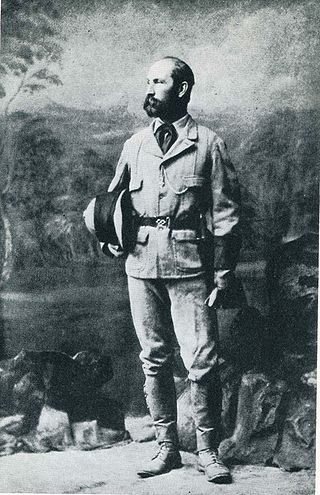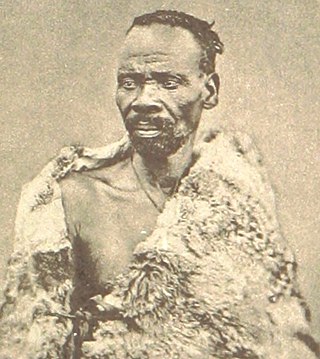
The South African Republic, also known as the Transvaal Republic, was an independent Boer republic in Southern Africa which existed from 1852 to 1902, when it was annexed into the British Empire as a result of the Second Boer War.

Stephanus Johannes Paulus Kruger was a South African politician. He was one of the dominant political and military figures in 19th-century South Africa, and State President of the South African Republic from 1883 to 1900. Nicknamed Oom Paul, he came to international prominence as the face of the Boer cause—that of the Transvaal and its neighbour the Orange Free State—against Britain during the Second Boer War of 1899–1902. He has been called a personification of Afrikanerdom, and remains a controversial figure; admirers venerate him as a tragic folk hero.

The Orange Free State was an independent Boer sovereign republic under British suzerainty in Southern Africa during the second half of the 19th century, which ceased to exist after it was defeated and surrendered to the British Empire at the end of the Second Boer War in 1902. It is one of the three historical precursors to the present-day Free State province.

The First Boer War, was fought from 16 December 1880 until 23 March 1881 between the United Kingdom and Boers of the Transvaal. The war resulted in a Boer victory and eventual independence of the South African Republic. The war is also known as the First Anglo–Boer War, the Transvaal War or the Transvaal Rebellion.

The Republic of Stellaland was, from 1882 to 1883, a Boer republic located in an area of British Bechuanaland, west of the Transvaal. After unification with the neighbouring State of Goshen, it became the United States of Stellaland from 1883 to 1885.

The Boer republics were independent, self-governing republics formed by Dutch-speaking inhabitants of the Cape Colony and their descendants. The founders – variously named Trekboers, Boers and Voortrekkers – settled mainly in the middle, northern, north-eastern and eastern parts of present-day South Africa. Two of the Boer Republics achieved international recognition and complete independence: the South African Republic and the Orange Free State. The republics did not provide for the separation of church and state, initially allowing only the Dutch Reformed Church, and later also other Protestant churches in the Calvinist tradition. The republics came to an end after the Second Boer War of 1899–1902, which resulted in British annexation and later incorporation of their lands into the Union of South Africa.

The Battle of Majuba Hill on 27 February 1881 was the final and decisive battle of the First Boer War that was a resounding victory for the Boers. The British Major General Sir George Pomeroy Colley occupied the summit of the hill on the night of 26–27 February 1881. Colley's motive for occupying Majuba Hill, near Volksrust, now in South Africa, may have been anxiety that the Boers would soon occupy it themselves, since he had witnessed their trenches being dug in the direction of the hill.

The Treaty of Vereeniging was a peace treaty, signed on 31 May 1902, that ended the Second Boer War between the South African Republic and the Orange Free State, on the one side, and the United Kingdom on the other.

The Volksraad of the South African Republic was the parliament of the former South African Republic (ZAR), it existed from 1840 to 1877, and from 1881 to 1902 in part of what is now South Africa. The body ceased to exist after the British Empire's victory in the Second Anglo-Boer War. The Volksraad sat in session in Ou Raadsaal in Church Square, Pretoria.

Major General Sir George Pomeroy Colley, was a British Army officer who became Governor and Commander-in-Chief of Natal and High Commissioner for South Eastern Africa. Colley was killed in action, at the Battle of Majuba Hill.

The London Convention was a treaty negotiated in 1884 between Great Britain, as the paramount power in South Africa, and the South African Republic. The London Convention superseded the 1881 Pretoria Convention.

The Colony of Natal was a British colony in south-eastern Africa. It was proclaimed a British colony on 4 May 1843 after the British government had annexed the Boer Republic of Natalia, and on 31 May 1910 combined with three other colonies to form the Union of South Africa, as one of its provinces. It is now the KwaZulu-Natal province of South Africa.

The Nieuwe Republiek was a small Boer republic which existed from 1884 to 1888 in present-day South Africa. It was recognised only by Germany and the South African Republic. Its independence was proclaimed on August 16, 1884, with land donated by the Zulu Kingdom through a treaty. It covered 13,600 square kilometres (5,300 sq mi) and the capital was Vryheid or Vrijheid, both being alternative names of the state. The founder and president until it requested incorporation into the South African Republic on 20 July 1888 was Lucas Johannes Meyer, while Daniel Johannes Esselen acted as Secretary of State during the same period.

Sekhukhune I was the paramount King of the Marota, more commonly known as the Bapedi, from 21 September 1861 until his assassination on 13 August 1882 by his rival and half-brother, Mampuru II. As the Pedi paramount leader he was faced with political challenges from Voortrekkers, the independent South African Republic, the British Empire, and considerable social change caused by Christian missionaries.

The Vice State President of the South African Republic was the second highest political position in South African Republic.

Ewald Auguste Esselen was a South African barrister who served as State Attorney of the South African Republic from 1894 to 1895.

The Paardekraal Monument is situated in Krugersdorp, South Africa. The monument commemorates the original site of vow made by Transvaal Boers on 13 December 1880, prior to the armed rebellion known as First Boer War, when they vowed to regain their independence from the British Empire. This earlier monument was a cairn made of thousands of stones representing the gathered burgers' vow. This official monument enclosed the original stone cairn and was built in 1890 by the South African Republic (ZAR) to commemorate their independence from Great Britain.

Lucas Johannes Meyer, was a Boer general, member of the Transvaal government and president of the Nieuwe Republiek.

General Jacobus Philippus Snyman was one of the dominant military figures in the South African Republic during the 19th century. He was the District Commissioner, Native Commissioner, and Commandant for the Marico district and led the Rustenburg and Marico commandos during the Second Boer War. Nicknamed Hamerkop, Snyman came to international prominence as the military commander at the Siege of Mafeking from November 1899 to May 1900.



















